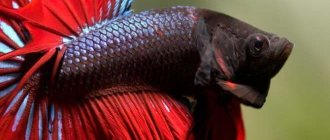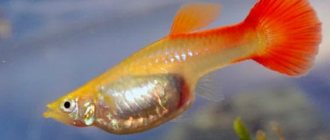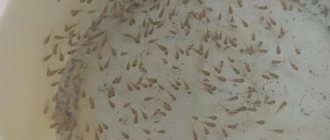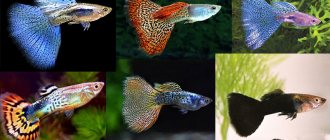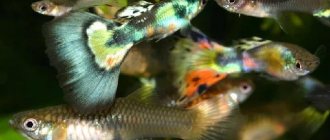There are many different species of fish in the world, and if you have an aquarium at home, it is important to be aware of all things fish related. The first thing to remember is that not all fish species can live together in harmony. In fact, fundamental aspects of fish behavior will depend largely on the species.
Is your fish pregnant?? ? If so, how long is the fish pregnant? Read here on HowMeow.ru to find out everything you need to know about fish pregnancy , including the gestation period of a fish and how to tell if your fish is about to give birth.
How do fish reproduce?
Fish reproduction can occur in one of two ways, depending largely on whether fertilization occurs inside or outside the body. A fish can become pregnant in the following ways:
- Ovoid fish: Fertilization is external, meaning the female first lays eggs, which are then fertilized by the male outside the body. Depending on the species, eggs can be laid on the bottom of the aquarium/ocean, float, stick to rocks or algae, hide in nests, or be transported in the body.
- Live fish: Fertilization is internal, meaning the male fertilizes the eggs inside the female. The fry's body is born fully formed.
- Ovovipary fish: They have a different type of internal fertilization. After sexual intercourse, the female will carry eggs inside her body so that the fry (fry) mature. These eggs will be incubated in the body or removed first.
In the case of internal fertilization we refer to fish pregnancy . However, it is important to keep in mind that when it comes to fish that give birth in an aquarium, we must have a clear understanding of what species of fish we are treating as fish pregnancy will vary greatly depending on the species.
For more information, we recommend reading our article where we discuss how do fish reproduce?
Why is it so important to determine the “position” of the fish in time?
Danio is one of the easiest fish to breed, but inexperienced aquarists often have difficulties. The onset of pregnancy can be confused with signs of some disease and completely inappropriate measures can be taken. In addition, for successful spawning it is necessary to provide suitable conditions, since pregnant individuals cannot always spawn in a general aquarium.
A female that fails to spawn in time is doomed to death. Thus, it turns out that in any case you need to carry out proper spawning, even if you do not plan to breed fish.
Sexual identification of fish
For egg laying and pregnancy in fish, it is important that both males and females are present. Considering the large number of fish species, there is no rule to follow when it comes to differentiating between the sexes and determining the sex of a fish .
In some cases, identification of fish genus is easy due to sexual dimorphism . Sexual dimorphism is when male and female fish exhibit physical and visible differences, making identification easier. In some fish species, the males will have a different color or shape than the females. For example, when it comes to determining whether a betta fish is male or female, females have noticeably shorter fins.
But we must also remember that there are also hermaphrodite fish that carry male and female gonads. Additionally, in other cases, fish are also sometimes born as one gender, but develop into the other once they mature.
For more information, we recommend reading our article where we look at the stages of fish embryo development...
What happens if the female is not allowed to spawn on time?
Danios are capable of spawning even in a community aquarium, and sometimes this happens unnoticed by the aquarist, so many beginners do not take any additional action.
In fact, for guaranteed spawning of Danio, two conditions must be met:
- separate aquarium (spawning area);
- a sufficient number of males (there should be 2 times more than females).
In a general aquarium, pregnant individuals often do not start spawning, because other fish interfere with them, or the school of Danio itself is characterized by an unbalanced ratio of males and females. As already about directly helping “girls” to free themselves from caviar.
Thus, if suitable conditions are not met, then the eggs inside the female will become overripe, the fry from them will no longer develop, and the individual itself will develop a cyst. This can lead to various complications: from loss of reproductive function to death.
In addition, it is important to know that in nature, Danios perform several spawnings in a row (with a break of 10-12 days). Beginners often think that everything is over at the first spawning, but after 1-1.5 weeks the females need to be placed in the spawning area again so that they are finally freed from eggs.
It often happens that the eggs are not yet ripe, and the pregnant individual hides from the male. In this case, the fish just need to be left in the spawning area for several days until spawning occurs.
What to do if the female doesn’t succeed?
If you understand that the fish is full of eggs, but for some reason the males cannot help it spawn, then you will have to intervene yourself:
- You need to take out a pregnant fish, carefully wrap it in wet cotton wool or soft cloth and at the same time carefully hold the fish in your left hand.
- Using the index finger of your right hand, gently press on the abdomen to squeeze out the eggs; this must be done very carefully so as not to harm the fish.
If everything went well, then the females need to be returned to the general aquarium, and after a couple of weeks, re-spawning should be carried out.
Is my fish pregnant??
So what is pregnancy like for fish ? Knowing whether a fish is pregnant or not can be difficult. The most common misunderstandings arise when food is supplied in excess and the fish become fat or due to the anatomical conformation of some species. For example, in egg-bearing fish, what may appear to be pregnant may be a sign of illness.
If you're wondering, is my fish pregnant? ? you should analyze these signs in detail:
- A lump growing under the stomach.
- Your body shape will change shape...
- There will be a visible spot in the abdomen area known as the gravity spot
- Some fish may release eggs when you pick them up
- In goldfish, males will chase females
Remember that fish reproduction depends on the species, not the water temperature.
You may also be interested in reading our article where we discuss how do guppy fish reproduce?
Swordtails
Female swordtails are ready to mate from the age of 8 months, because it is at this age that these fish end puberty. If a female swordtail is pregnant, a dark spot appears on her belly, and the belly itself takes on a rounded shape. Closer to childbirth, the tummy increases and takes on a square outline.
How long is a fish pregnant???
The length of pregnancy in fish will vary depending on the species and living conditions. In some cases, pregnancy will last a month, and the fry will be born already formed. Although other species may take up to two months to hatch a fish, here are a few examples:
How long is a guppy fish pregnant???
21-30 days.
How are they always pregnant with goldfish?
Goldfish technically cannot get pregnant. When it comes to goldfish, the females release unfertilized eggs into the water, so the male fertilizes them. It then takes 2-7 days before the goldfish egg hatches. This is the same with betta fish , whoever hatches usually hatch after 3 days..
How long is laminar fish pregnant???
About 28 days.
Keep reading to know how do fish give birth in an aquarium? .
Childbirth of a guppy: preparation for when you need to place a pregnant fish
For spawning, you can select a separate section in the aquarium, enclosing it with glass, if, of course, its volume allows. But, according to experienced aquarists, a few days before giving birth, it is best to move a pregnant female guppy into a separate small aquarium with a volume of 5–10 liters before throwing. As a last resort, the expectant mother can be moved into a three-liter jar or special plastic containers or trays that can be attached to the aquarium, thereby creating familiar living conditions for the expectant mother. Remember: Severe stress can delay labor.
Using separate containers or aquariums, do not forget to prepare the water and create the necessary conditions for the fish and its offspring.
Advice! If the aquarium is inhabited exclusively by guppies, there are many shelters in the form of ceramic figurines, driftwood, stones, algae; pregnant fish do not need to be transplanted, since some of the fry will certainly survive.
Pregnant guppies a day before giving birth
As already noted, if there are other fish in the aquarium, it is best to remove the pregnant guppy while it is throwing, and then release it back into the aquarium after giving birth. In addition, she herself can eat part of her offspring, so the babies should be immediately moved to a small aquarium planted with algae to protect the babies while they are with their mother.
During childbirth, the female's tail trembles and she freezes for a few seconds. Live, nimble fry emerge from the anus and immediately begin to actively swim.
A dark spot on the abdomen is a sign of guppy pregnancy
The number of fry depends on the age of the guppies. As a rule, young fish produce from 8 to 10 fry, and adult, mature fish are capable of producing from 30 to 100 or more fry.
It is also worth noting that postpartum guppies can become pregnant a few hours after the fry are born. In this case, females can store sperm from males for 10–12 months. It all depends on the conditions in the aquarium. During its life, a guppy produces about 2,000 fry.
Caring for fry
Compared to the fry of guppies and swordtails, the fry of mollies are larger (up to 7 mm), but with a weak body. If the parents are well fed, they will not eat their fry. There are cases of mollies attacking offspring. At first, newborns lie on leaves and soil. After a couple of days, the fry become independent.
What to feed
When the fry begin to awaken, they begin feeding. Young animals eat 3–5 times a day in small portions. Suitable for feeding small fish in the first days:
- Cyclops;
- ciliates;
- Artemia;
- chopped tubifex;
- Daphnia;
- dry food ground into dust;
- special feed.
Live and frozen food will provide the fry with the necessary substances and make them grow faster. Live food is washed under running water before consumption.
How long do they grow?
After 1–2 months, the first sexual signs appear. Males can be distinguished from females by their cone-shaped gonopodium and bright coloration. Males are slender with large fins, grow up to 8 cm in length, and females - up to 12. After the appearance of sexual differences, the mollies fry are settled in different containers.
How to grow
To raise fry you need:
- weekly water changes;
- aquarium with a volume of 30–40 liters with a filter and aerator;
- constant temperature at 26 degrees, hardness and pH;
- shelters and plants if the fry grow in a community aquarium.
Home of the aquarium betta
This representative of the fauna lives in fresh water bodies of Thailand, Malaysia, and Vietnam. He loves standing warm water.
Local residents fell in love with these cute fish not only because of their beauty. People have noticed that the males of this breed are very lively. Therefore, the Thais began to organize fights with the participation of Siamese cockerels. For some, this business became a source of income, since the bets were monetary.
Gradually, people in other countries learned about the wonderful inhabitants of the deep sea. They began to be exported to France and Germany, then they appeared in other countries.
How long does a guppy's pregnancy last?
Guppy pregnancy lasts on average 21-24 days. There are known cases when the duration of gestation was 42 days. The duration of pregnancy is influenced by the following factors:
- age of the fish;
- her state of health;
- stress;
- water temperature;
- conditions of detention;
- feeding.
When the fish is kept in poor conditions, in the presence of stress and inadequate feeding, the gestation period increases. Diseases slow down the development of eggs, and in some cases can cause miscarriages and miscarriages. In young fish, pregnancy lasts longer than in older guppies. A slight increase in water temperature (up to 24-26°C) accelerates the development of eggs. Severe stress can trigger premature birth. Fry born prematurely, as a rule, do not survive.
Fertilization process
Sperm are introduced into the female's genital opening using the gonopodium. The formation of the copulation organ begins during puberty. Before this, there are no differences in the structure of the anal fin of the female and the male. With the onset of puberty, the rays in cross-section resemble a triangle, and later a tube.
The tube, equipped with muscle fibers, rises or falls, which facilitates the introduction of spermatophores - “packets” of sperm into the female’s body. They are partially spent on fertilizing part of the eggs, and a certain amount of seed material is stored inside the reproductive organs of the female for several months. In guppies, as a result of one insemination, from 5-6 to 11 marks often occur.
When the female is completely ready to mate, she releases a special secret into the environment that attracts males to her. They also have a chemical effect on the mating behavior of females. Copulin secreted by the gonads of males forces the female to take a position that is most convenient for inserting the gonopodium into the genital opening. The female's swimming in an inclined position is another sign of her readiness for copulation.
But such chemical “markers” of readiness for procreation do not replace physical stimulation. The male begins a courtship dance around the female, spreading his fins and sparkling with the bright color of his body, he quickly rushes around the chosen one. Several males can “chase” a female at once.
Interestingly, each male has his own dance, which he repeats in great detail during each mating. This mating ritual is enshrined in the genetic memory of males. If he does not “court,” the female will not allow the male to approach her, despite the chemical marks.
The female also chooses a “gentleman” based on the brightness of the color and the length of the fins. The winners are males with red coloring or red spots and long fins. They grow in males throughout their lives and indicate longevity and good health. These qualities are desirable in offspring. Thus, information about his viability as the father of numerous offspring is “encoded” in the male’s appearance.
Signs of pregnancy
Determined by birthmark. Located on the abdomen, next to the anus and fin. As the deadline approaches, it darkens and increases in size.
Photo gallery of pregnant guppies:
How does childbirth occur?
Guppy labor begins at night or in the morning and lasts up to several days. Most often, childbirth occurs without complications. During the reproductive process, guppy fry are released in batches or individually at different time intervals. The fish's tail trembles violently, then freezes, and the babies appear. The behavior of the fry may vary: some of them will be full of energy, while others will be slow and inhibited. The difference is due to the fact that some newborns take time to gain strength.
How to tell if a female guppy is about to give birth
In the later stages of pregnancy, the female's abdomen becomes rectangular, and the dark spot at the anal fin becomes extensive. It brightens before birth. Through the thin skin of the fish in this area, you can see the outlines of the bodies and eyes of the fry. 1-2 hours before birth, a triangular protrusion forms on the female’s cloaca.
Not only the appearance, but also the behavior of the guppies changes before giving birth. The female loses her appetite, becomes restless, and begins to tremble. She strives to retire and hide from other fish, swimming away into thickets of plants or other shaded places. Guppies often give birth near the bottom or corner of the aquarium, behind a filter or heater. If the surface of the water in the aquarium is covered with floating plants, the fish may choose them as a place to give birth.
Depositing - behavior before childbirth
The body changes. The abdomen protrudes from the sides, downwards. A distance in the form of a protrusion is formed between it and the head. The female is moved into a separate container of 3-5 liters. The bottom is covered with Java moss so that newborns can hide. If the process takes place in a common aquarium, follow 2 rules:
- lack of other fish species;
- the presence of greenery to shelter young animals.
Jigging is carried out shortly before birth, so that the female does not experience severe stress when changing her environment. Special soil is not placed on the bottom of the spawning tank. The water must be clean. For a general aquarium, purchase a special tray.
Breeding environment and mating
These fish can be propagated both in the aquarium itself and in a special place, the so-called spawning ground. It is not necessary to buy a special container for these purposes and instead use a regular jar with a capacity of 3 liters. Pour fresh, settled water into it, some algae and place the female and male there. You can speed up mating by simply raising the temperature of the water in the spawning tank (by no more than 4 degrees) and replacing a third of the total amount of water .
Use strictly settled water, not from the tap.
The male guppy fertilizes the female with his reproductive organ, the gonopodium. It looks like a fin with several tubes. Available only in males who have reached sexual maturity.
It is also not difficult to understand that mating has begun. If the male starts chasing the female, the process has begun. At this moment, it is important to understand and take into account one detail. When mating occurs in an aquarium where all the fish live, there should not be very many males there. If this is the case, then the female should be placed with one of them. Because being in a common environment, the fish runs the risk of disappearing. Males can drive her, at best, to the point of complete exhaustion, at worst, to death.


